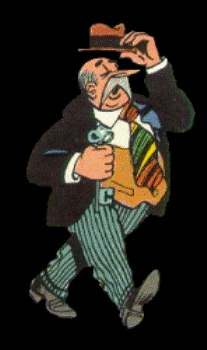Character
Meneer Pheip is an obese, middle-aged man with a large moustache. He is very stingy, chauvinistic and prone to aggression. He frequently quarrels with Nero and gets into fights with Abraham Tuizentfloot. Pheip isn't very bright either. He is a frequent victim of Madam Pheip's dominant behaviour. She forces him to do domestic chores and beats him up when he insults her or looks at other women. Despite being a violation of the law of marriage he carries her name instead of the other way around. Madam Pheip also frequently beats him up whenever he insults her or looks at other women. In "De Terugkeer van Geeraard de Duivel" ("The Return of Geeraard de Devil") (1983) she even keeps him close to her by means of a chain. [1] Meneer Pheip has rebelled against his wife's bullying in some stories. In "Mama Kali" (1969) he goes on safari to Tanzania without her. In "De Groene Chinees" ("The Green Chinese") (1955) he is so jealous that he forbids her to go on new adventures with Nero. In "De Zwarte Toren" ("The Black Tower") (1983) he even kidnaps Nero to become the series' new protagonist. The Pheips also kidnap Nero's son Adhemar in "De Zoon van Nero" ("Nero's Son") (1959), out of jealousy over the child's genius.
Meneer Pheip is a rich business man and politician, despite sometimes suffering from a lack of money in later stories. In "De Totentrekkers" ("The Ugly Face Makers") (1970) he is declared bankrupt. In "Het Spook van Zoetendaal" ("The Ghost of Zoetendaal") (1979) he is rich enough again to buy a castle in Zoetendaal. Like many rich people in Belgium during the 1950s Pheip speaks French. He also reads the French-language newspaper "Le Moniteur" and takes his holidays at the Côte d'Azur. When Nero and the Pheips are mountain climbing in "De Pax-Apostel" ("The Pax Apostle") (1958) Nero manages to make Pheip climb quicker and higher than everybody else by telling him to "remember the Six hundred Franchimontois". [2]
The character was inspired by the real-life mayor of Moerbeke, Jean Mariën. Much like Meneer Pheip he too owned a local sugar factory, [3] had a moustache and was short and obese. Some sources claim Maurice Lippens was the main inspiration. [4]
Youth, career and other activities
In "De Adhemar-Bonbons" ("The Adhemar Pralines") (1990) it is revealed that Pheip resembled Clo-Clo during his youth. In his debut appearance we don't learn his first or last name, but after marrying Madam Pheip everyone refers to him as "Meneer Pheip" ("Mister Pheip"), despite the fact that this is a violation of the law of marriage which insists that a woman takes her husband's name instead of the other way around. His first name is different in many albums: Isidoor, [8] Antoine, [9] Charles-Louis [10] and Oscar [11] In later stories people refer to him as "Philemon" and author Sleen seems to settle on this name. [12]
In "De Zwarte Voeten" ("The Black Feet") (1951) Meneer Pheip is mayor of the Belgian city Moerbeke-Waas in East Flanders. In later stories he is no longer politically active. Only in "De Bende van Lamu" ("Lamu's Gang") (1987) does Madam Pheip ask him to return to politics. Pheip decides to become mayor of Voeren, because "he speaks both national languages". In "De Indiaanse Neusfluit" ("The Indian Nose Whistle") (1987) he succeeds in this ambition, thanks to Adhemar's Dutch language course. This is all a reference to the 1980s José Happart crisis. [13] Pheip even angers Belgian politician Jean Gol with his linguistic knowledge [14] In the next three stories Pheip remains mayor of Voeren.
Meneer Pheip has unsuccessfully tried to master the violin, [15] became an association football referee, [16] champion ski jumping 1958 [17] and studied at the University of Oxford for a year. [18] He also had a common hill myna for a pet [19] and once a kiwi. [20]
Language
Meneer Pheip is notable for his eccentric use of Dutch and French. He often mixes words from both languages and uses French sentence construction. He also frequently translates French and Dutch words literally. Nero is often irritated by Pheip's use of language, wondering when he'll ever master proper Dutch? However, Pheip has succeeded learning Dutch several times. In "Het Zevende Spuitje" ("The Seventh Syringe"), Uitgeverij Het Volk, 1963 Adhemar accidentally makes him speak Algemeen Beschaafd Nederlands by injecting him with an experimental serum. When the serum's power has run out Pheip loses this ability again. Adhemar taught Pheip Dutch twice, failing in "De Groene Gravin" ("The Green Duchess") (1975), but succeeding in "Het Spook van Zoetendaal" ("The Ghost of Zoetendaal") (1980-1981) where Adhemar advised him to read "Taalwenken" by Marc Galle. Because Pheip once again forgets everything he learned by the next story Adhemar teaches him again, with success, in "De Indiaanse Neusfluit" ("The Indian Nose Flute") (1987), but once again Pheip returns to his old, familiar language again by the end of the next story.
Pheip's combination of Dutch and French can be seen as a satirical take on "franskiljons". [21]

The Adventures of Nero or Nero was a Belgian comic strip drawn by Marc Sleen and the name of its main character. The original title ranged from De Avonturen van Detectief Van Zwam in 1947 to De Avonturen van Nero en zijn Hoed in 1950, and finally De Avonturen van Nero & Co from 1951. It ran in continuous syndication until 2002. From 1947 until 1993 it was all drawn by Sleen himself. From 1992 until 2002 Dirk Stallaert took over the drawing while Sleen kept inventing the stories.
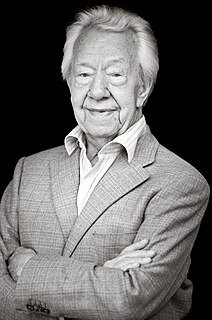
Marcel Honoree Nestor, Knight Neels, known as Marc Sleen, was a Belgian cartoonist. He was mostly known for his comic The Adventures of Nero and Co., but also created gag comics like Piet Fluwijn en Bolleke, De Lustige Kapoentjes, Doris Dobbel, Oktaaf Keunink and De Ronde van Frankrijk.
The Bronzen Adhemar is the official Flemish Community Cultural Prize for Comics, given to a Flemish comics author for his body of work. It is awarded by the Flemish Ministry of Culture during Strip Turnhout, the major Flemish comics festival, once every two years.

Merho, born Robert Merhottein on 24 October 1948, is a Belgian comic-book writer and artist, best known for creating the comic strip De Kiekeboes.

Willy Linthout is a Belgian comics author, best known for the Urbanus comics and his graphic novel Years of the Elephant.
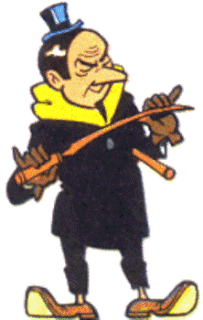
Krimson is a Flemish comic book character and the main antagonist in the Belgian comic strip series Suske en Wiske. He is a doctor, billionaire and supervillain who wants to take over the world.
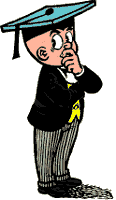
Adhemar is a Flemish comic book character. He is the son of Nero in the eponymous Belgian comic strip series The Adventures of Nero by Marc Sleen and one of the main protagonists. He is a child prodigy who is both a professor as well as an inventor. His full title is doctor professor Adhemar. He is easily recognizable due to his beret and tuxedo.
Nero is a Flemish comic book character and the main protagonist in Marc Sleen's long running comic book strip series The Adventures of Nero (1947–2002). He is one of the most recognizable comic book characters in Belgium and comparable to Lambik from the Suske en Wiske series by Willy Vandersteen.

Ricardo is a Flemish comic book character and the main antagonist in The Adventures of Nero series by Marc Sleen. He is a ruthless maffiosi who hates Nero with a passion. Together with Geeraard de Duivel and Matsuoka Ricardo is Nero's most frequent opponent, appearing in at least 24 albums, even surviving several seemingly deaths.

Abraham Tuizentfloot, in full Oscar Abraham Tuizentfloot, is a Flemish comic book character from the Belgian comic book series The Adventures of Nero by Marc Sleen. He is a crazy little man who dresses up as a pirate and has a tendency to attack people. In the series he is one of Nero's personal friends.

Piet Fluwijn en Bolleke was a Belgian gag-a-day comic strip series drawn by Marc Sleen from 1944 until 1965. It was continued by artists Hurey and Jean-Pol until 1974.
Ons Volkske was the youth supplement of the Flemish newspaper Ons Volk Ontwaakt. It was published without interruption from 1932 until 1988, except for the years during World War II. The magazine was notable for its comics and together with 't Kapoentje it was the most important comic book magazine in Flanders.
't Kapoentje was a youth supplement published by the Flemish newspaper Het Volk from April 3, 1947 until 1989. It was notable for its comics and, together with Ons Volkske, the most important comic book magazine in Flanders.
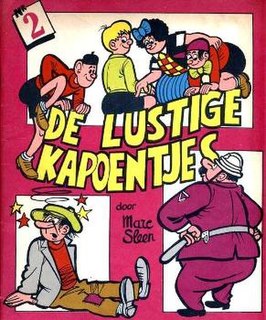
De Lustige Kapoentjes was a long-running Flemish comic book series, which existed under different titles and was drawn by different artists, among whom Marc Sleen and Willy Vandersteen are the most well known. The series was published in 't Kapoentje, the youth supplement of Het Volk, and in Ons Volkske, the youth supplement of De Standaard. They were the mascots of 't Kapoentje from 1947 until the magazine's demise in 1985.
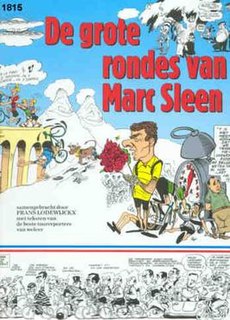
De Ronde van Frankrijk was a Belgian gag cartoon comic strip series by Marc Sleen, in which he made a comedic report of every daily tournament of the annual cycling contest the Tour de France. Sleen drew the strip each year, from 1947 up until 1964, for the Flemish newspapers Het Vrije Volksblad and Het Volk.
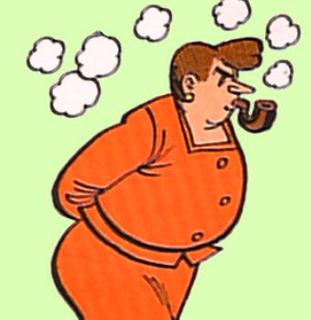
Madam Pheip is a character from the Flemish comic strip The Adventures of Nero by Marc Sleen. In the series she is one of Nero 's personal friends and married to Meneer Pheip, with whom she has one child, Clo-Clo. Madam Pheip also adopted two children, Petoetje, and Petatje.
Detective Van Zwam is a Flemish comics character in the Belgian comics series The Adventures of Nero by Marc Sleen. He is a brilliant detective and able to find clues from even the tiniest of evidence.
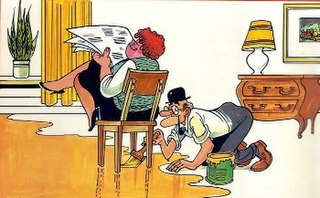
Oktaaf Keunink was a Belgian comics series, written and drawn by Marc Sleen. It was published between 16 November 1952 and 4 April 1965 in the magazine Ons Zondagsblad.
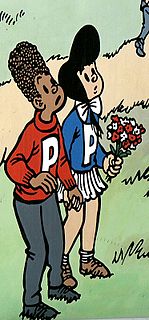
Petoetje is a Belgian comics character from the comic strip The Adventures of Nero by Marc Sleen. He is a teenage black boy who originates from Papua New Guinea, but was adopted by Madam Pheip and Meneer Pheip, along with another orphan child, Petatje.

Petatje is a Belgian comics character from the comic strip The Adventures of Nero by Marc Sleen. She is a teenage girl who was adopted by Madam Pheip and Meneer Pheip, along with another orphan child, Petoetje.
